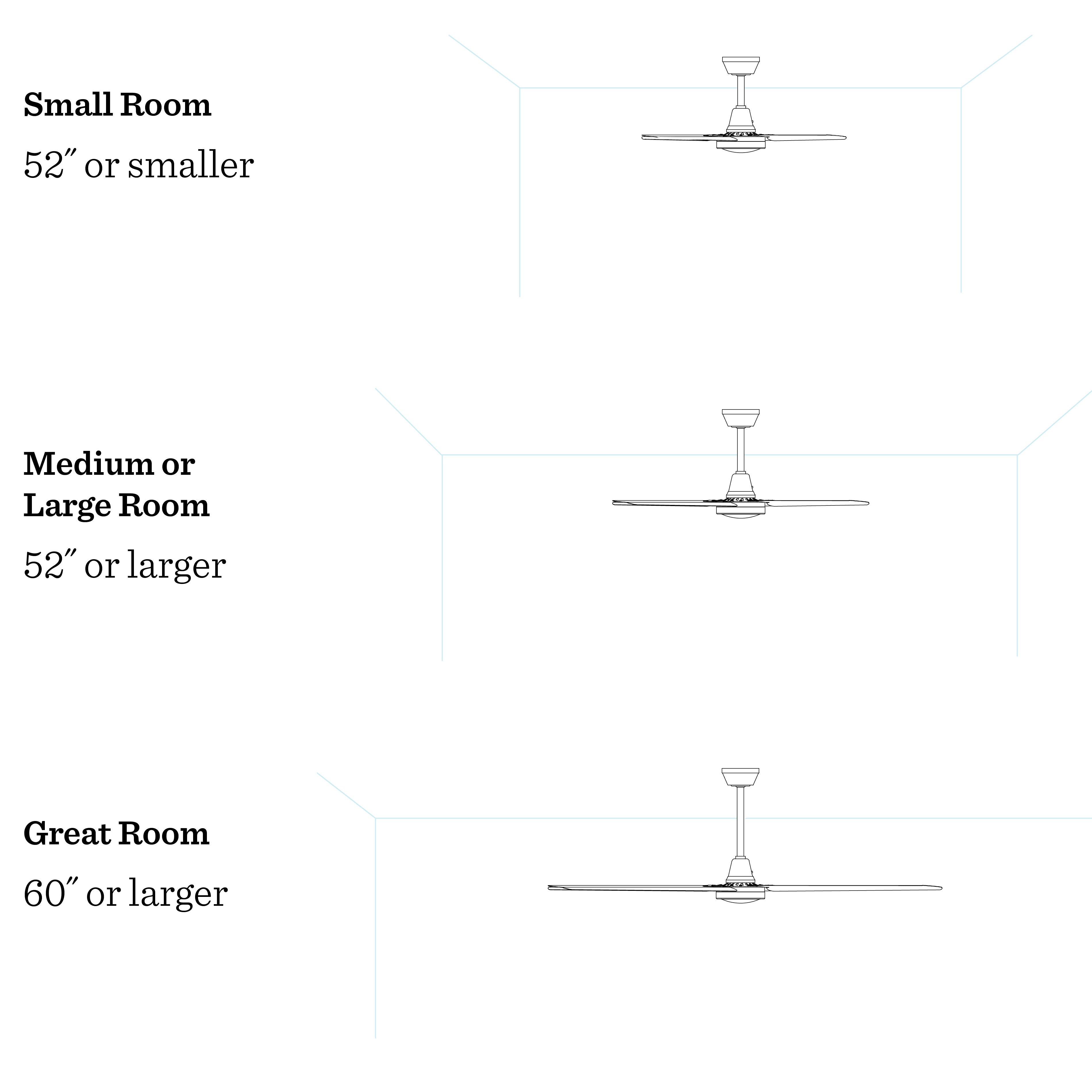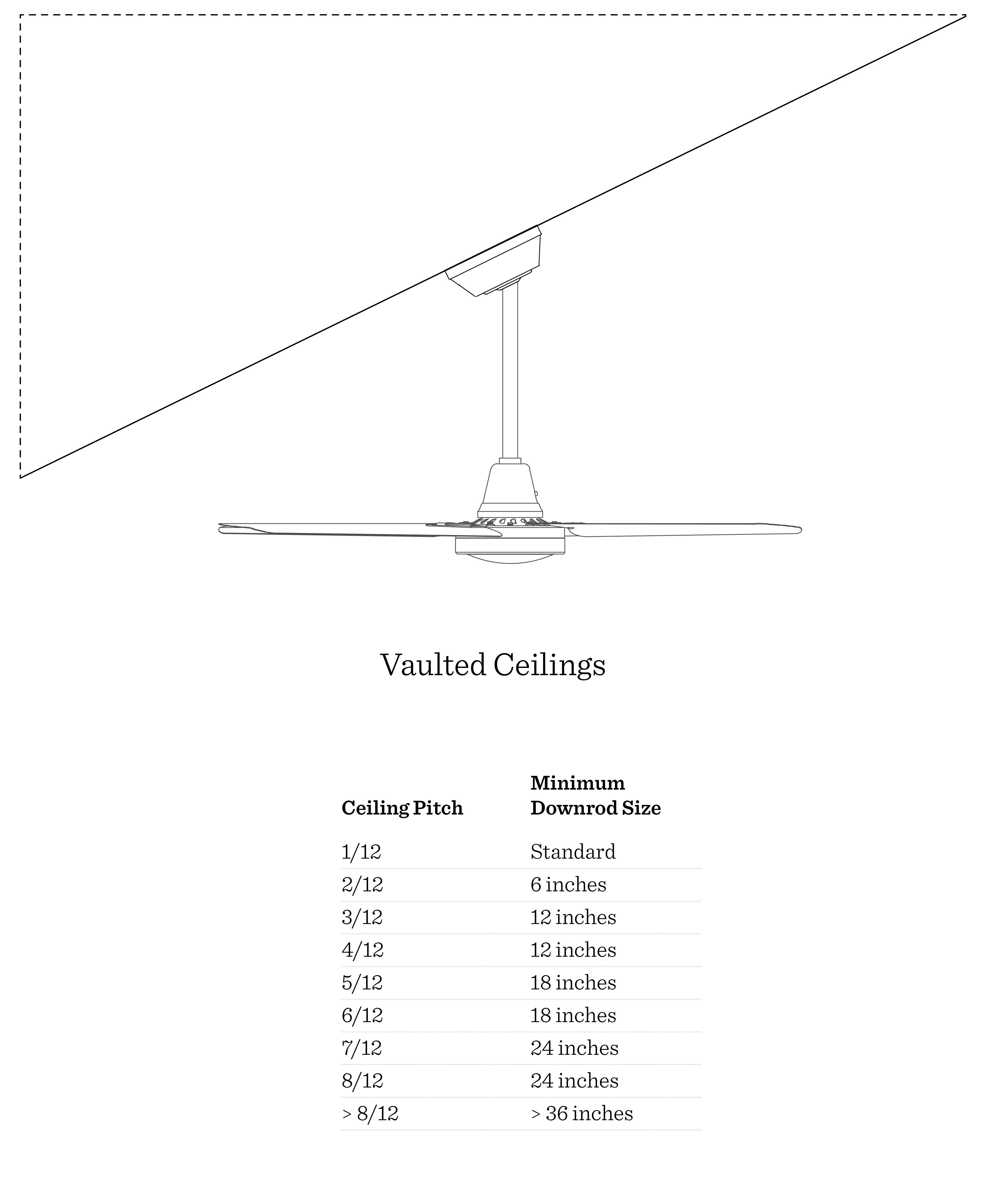How-To: Our Ceiling Fan Buying Guide

Downrod length? Ceiling pitch calculations? Airflow efficiency? Purchasing the right ceiling fan can be difficult if you don’t have information on your side. Lucky for you, we’re here to help. Read on to learn everything you need to know to equip your space with a beautiful new ceiling fan from Schoolhouse.
Moisture and electronics don’t usually get along, so if your ceiling fan is going to be exposed to the elements, you’ll want to make sure it’s designed to handle them. Our ceiling fans come rated for use in wet environments (areas with where the ceiling provides the only protection from the elements) damp environments (areas that are exposed to full changes in humidity and possibly condensation, such as covered porches) and dry environments (indoors). Wet-rated and damp-rated ceiling fans can be used in dry environments, but dry-rated ceiling fans can only be used in dry environments.

Q: Do your fans come with lights?
A: Most but not all of our fans come with LED light kits. Check the “Details” tab on the product page to see which fans do or do not.
When choosing the size of fan you need, your primary concern should be for how much air the fan can move. An undersized ceiling fan simply won’t do the job, especially if you rely on your ceiling fan on a regular basis. If you’re more technically inclined, you can check out the spec sheet for each fan model to view how much airflow output is required for a given size of room. An easier way to choose a fan is to use this system:


via @emilyhenderson
Once you’ve chosen a fan that can be effective in your space, you can start choosing fans for scale. Choosing the smallest necessary fan for your room will give a more traditional and discrete look to the fan installation while a large-format fan can function as a statement piece.
Q: Can your fans be used in an old house?
A: Yes! Our fans utilize standard 120V American house wiring. Just make sure to check that the ceiling substrate is sturdy enough to support the fan’s weight, or have a professional install the fan for you.

The downrod is the piece of metal tubing by which a ceiling fan is hung from the ceiling. This part helps to determine how high or low the fan will hang in the room. An ideal height for most ceiling fans is for the blades sit between seven and nine feet off the ground. Lower ceilings might not require any downrod at all, meaning they only need a basic ceiling mount construction. Other ceiling heights and their corresponding downrod lengths can be found in the illustration below.

Q: Can I change the blade or body color of my fan?
A: The specific color and finish options of our fan selection were chosen by our design team. We view this degree of curation as an important aspect of our decision to offer ceiling fans.
If you have a pitched ceiling, your ceiling fan will need to have a downrod that’s long enough to keep the sweep of the blades clear of the downward sloping ceiling. A ceiling’s pitch is defined as the amount the ceiling rises for every foot of width. (This might sound familiar if you remember calculating “rise over run” in middle school geometry.) Most homes have a ceiling pitch that falls into one of just a few traditional ratios, and these ratios are usually expressed as “X/12.” A “2/12” roof pitch rises two inches for every twelve inches it runs.
If you don’t already know your roof’s pitch, calculating it is relatively simple. Just measure the difference in height from the bottom of the slope to the top of the slope as well as the width of the slope (parallel to the floor, not parallel to the angle of the roof). Convert these measurements into inches and then reduce the ratio to an “X/12” fraction. (Hint: If you did this right and the home was built under standard procedures, “X” should be a whole number between 1 and 12.) Then, choose your downrod length from the chart below.


Q: Are fans easy to clean?
A: Yes! All of our fans feature modern finishes that are easy to clean and maintain. For most applications, a light dusting is the only maintenance required. When more cleaning power is needed, a mild, all-purpose household cleaner and a soft rag should do the job.
A little-known fact about ceiling fans is that they can be helpful for regulating a room’s temperature in both warm and cool seasons by simply changing the rotational direction of the fan’s blades. In warm weather, you’ll want to feel the circulation of air as moving air is what helps to provide the cooling, evaporative breeze ceiling fans are known for. For this purpose, a counterclockwise rotation is ideal. During cooler months, however, you can warm up a room by setting the fan on a clockwise rotation and pushing hot air that has risen to the ceiling down and recirculating it around the room.

Energy efficiency is an important consideration when calculating operating costs and energy expenditure for environmental reasons. For ceiling fans, the best way to think about a fan’s efficiency is to look at its airflow efficiency which is defined as the amount (in cubic feet) of air the fan moves per minute, per watt of energy. The higher the cfm/W rating, the more efficient it is. All of our fans meet the standards of the Energy Star rating program, meaning they are extremely efficient at converting energy to airflow.








